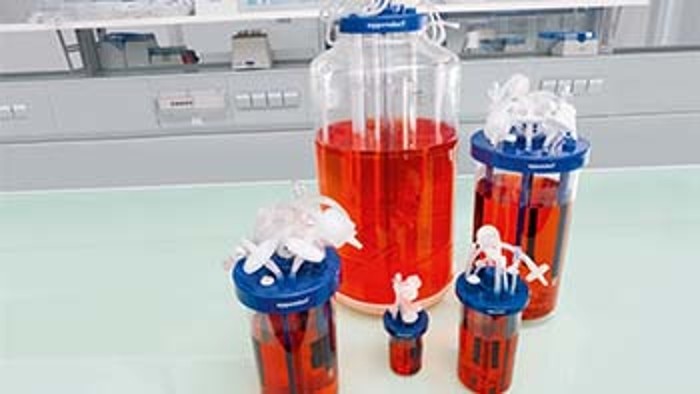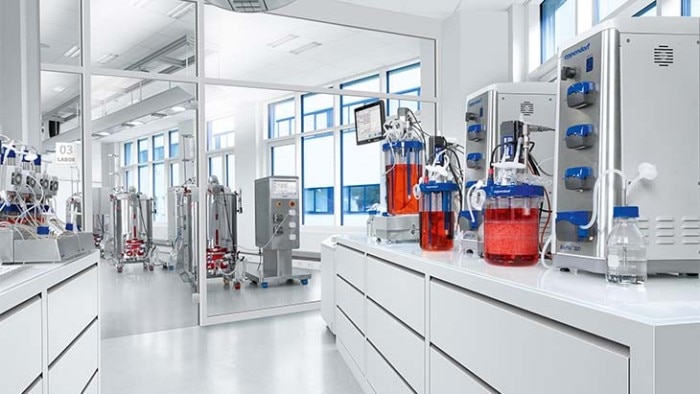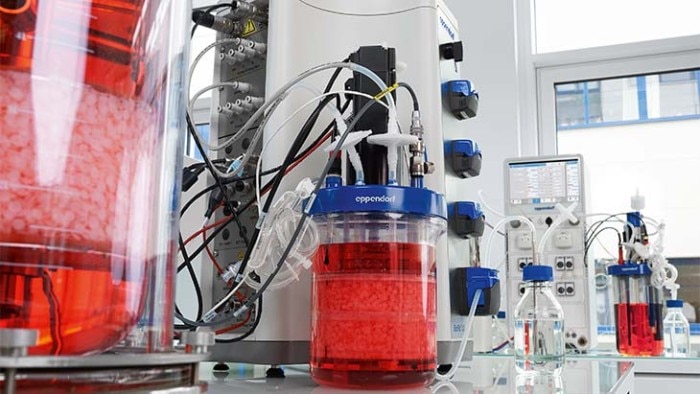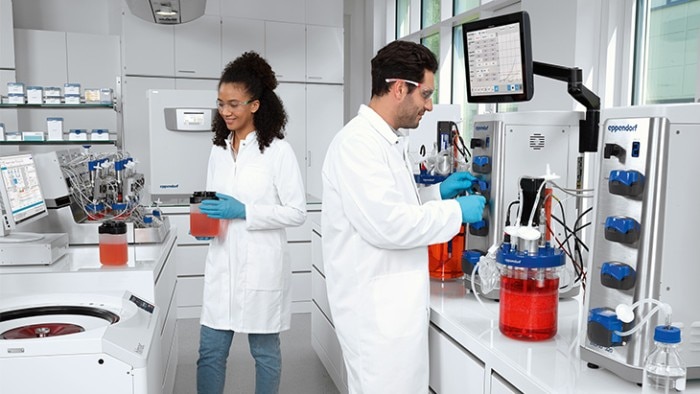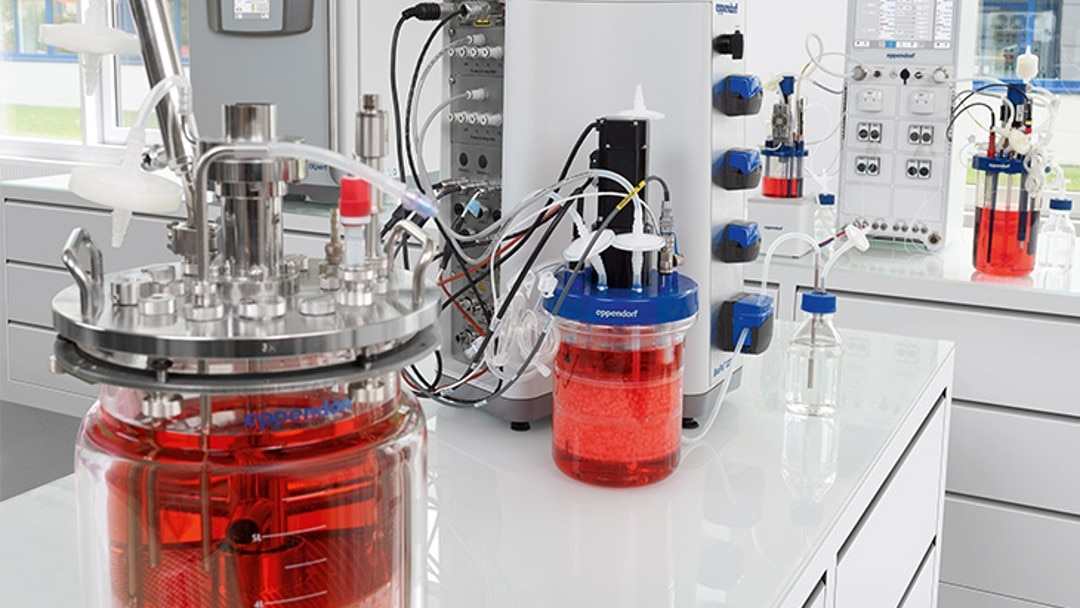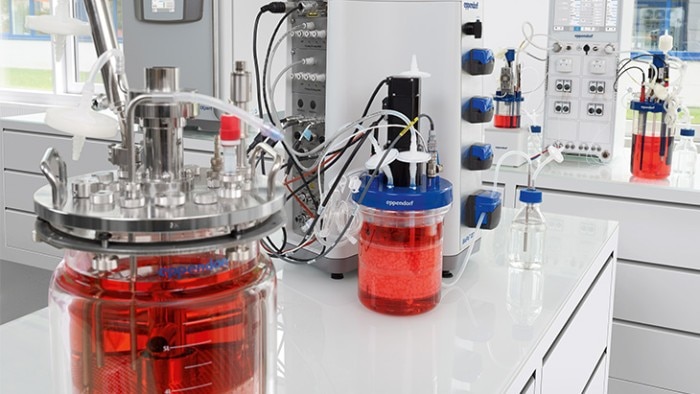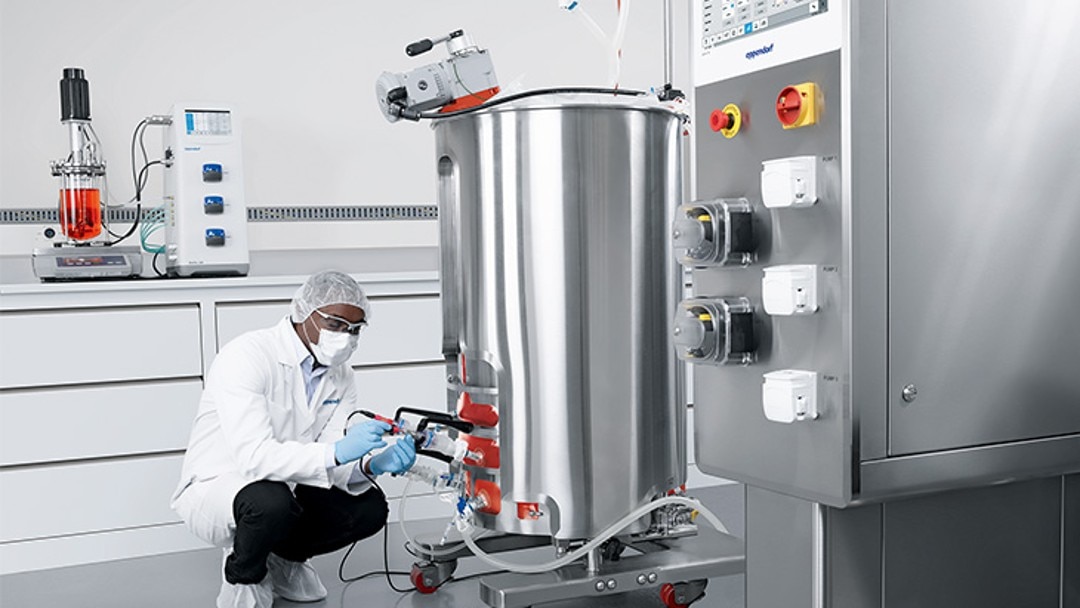MENU
AU | AUD
AU | AUD
-
- Benchtop Centrifuges
- Floor-Standing Centrifuges
- Refrigerated Centrifuges
- Microcentrifuges
- Multipurpose Centrifuges
- High-Speed Centrifuges
- Ultracentrifuges
- Concentrator
- High-Speed and Ultracentrifugation Consumables
- Accessories
- Tubes
- Plates
- Device Management Software
- Sample and Information Management
No results found
Search Suggestions
GMP info
Regarding the suitability of Eppendorf bioprocess equipment in GMP-regulated applications, please reach out to your Eppendorf sales representative.
Cell Culture in Bioreactors
Bioreactors can be used for the large-scale cultivation of various cell types, including mammalian cell lines, stem cells , and insect cells. Cell culture in bioreactors has a wide range of applications, including cell and gene therapy development , and the production of antibodies , vaccines , and viral vectors . There are many factors to consider when setting up these bioprocesses, including the optimization of critical process parameters, finding the right feeding strategy, and ensuring bioprocess scalability.
Read more
Read less
What factors should be considered when establishing bioreactor cell cultures?
The cultivation of human and animal cells in stirred-tank bioreactors offers many benefits: Cell culture in stirred-tank bioreactors is scalable, from research scale in the milliliter range to thousands of liters. High yields can be achieved, and batch-to-batch variability can be kept low. However, to achieve this, optimal growth conditions must be created in the bioreactor. In the following, we look at which factors are particularly important.
Read more
Read less
The shear force on the cell culture in bioreactors
In bioreactors, mixing of the culture is essential to ensure the homogenous transfer of oxygen and nutrients to the cells, for maximal cell growth and productivity. However, mixing generates shear forces, which, if too high, can damage “shear-sensitive” cells like mammalian and stem cells.To prevent potential drops in product yield and quality, the shear force on the cells must be considered. There are several ways to reduce the shear force imparted on the culture, while still maintaining effective mixing. This includes the type of impeller and the method of gassing.
Read more
Read less
Impellers
Impellers are agitation devices that are equipped with blades and are used in bioreactors to mix cell cultures. The orientation of impeller blades influences the shear forces on the bioreactor culture:
- Blades that are axial, or have a 45°-degree angle, provide gentle yet effective mixing that is suitable for sensitive cell cultures. Examples are pitched-blade impellers and marine impellers.
- Radial blades are suitable for more robust cell cultures, hence are more commonly used for microbial fermentation. An example is the Rushton impeller.
Read more
Read less
Gassing
The addition of gasses (referred to as ‘gassing’) is an essential aspect of bioprocessing, required to add oxygen into respirating cells. Gas can either be added into the bioreactor headspace, or sparged into the culture suspension, which influences the shear force on the cells. Gassing into the headspace is recommended for shear-sensitive cultures, as gassing within the culture introduces bubbles, which can cause shear forces when breaking up and potentially damage sensitive cells.
Read more
Read less
Regulation of critical process parameters
Critical process parameters
Critical process parameters (CPPs) are essential for cell growth, survival, and product formation. These can include, but are not limited to temperature, the dissolved oxygen concentration (DO), pH, and metabolite concentrations. Within cell culture in bioreactors, the critical parameters and their optimal setpoints must be identified before setting up effective monitoring and control systems to achieve maximum yields and productivity.
Read more
Read less
The regulation of CPPs is important for the yield and quality of biologics like monoclonal antibodies. Bioprocess monitoring and control is also particularly important for culturing high-quality stem cells, with the strict maintenance of an optimal culture environment required to support the reproducible and scalable cultivation.
Read more
Read less
Bioprocess monitoring and control
Bioreactor controllers can greatly improve the efficiency of parameter monitoring and control. These systems use real-time, in-process sensors to detect changes in parameters. This data is transmitted to integrated bioprocess control software that precisely regulates the adjustment of pumps, valves, or motors to maintain optimal parameter concentrations. This achieves automated and continuous parameter control, reducing the need for human intervention and providing a more constant culture environment to maximize product yield and quality.
Read more
Read less
Feeding bioreactor cell cultures
Bioreactor operation modes
When working with cell culture in bioreactors, the operation mode is an important consideration and refers to the strategic addition of substrates essential for cell growth and productivity. Several operation modes have been developed for bioreactor cultures, including batch, fed-batch, and perfusion culture. In batch fermentation, the substrate is added only at the start of the bioprocess. In fed-batch fermentation, batch fermentation is conducted for a period of time, followed by the incremental addition of substrate towards the end of the bioprocess to extend the culture’s productivity. However, the highest cell densities and yields can be achieved with perfusion culture, with continuous substrate addition.
Read more
Read less
Perfusion
Perfusion is a continuous culture technique with constant substrate addition, where cells are retained or recycled within the bioreactor, while the medium is exchanged to replenish nutrients and remove secreted products and by-products. This allows for a steady culture environment to be maintained to improve product yield and quality. Perfusion culture requires the use of a cell retention device. There are different options available, including (alternate) tangential flow filter devices, spin filters, and packed-bed bioreactors.
Read more
Read less
Prevent contamination of cell cultures in bioreactors
Contamination is a challenge for cell cultures in bioreactors. The cellular environment is a perfect balance of nutrients, oxygen, pH and temperature, which unfortunately allows unwanted microbes to thrive. Within just a few hours, microbial contaminants can take over a culture, resulting in wasted time, efforts, and money. Contamination can occur in all types of bioreactor cultures, although human and animal cell cultures are at a higher risk. These cells have a slower growth rate and so are less able to compete with faster growing microorganisms that may unintentionally be introduced into the culture.
Read more
Read less
Sources of contamination
Traditional, reusable bioreactors face an increased risk of microbial contamination. In these vessels, contamination can arise from several sources, including:
These bioreactors also have an increased risk of cross-contamination, if the equipment is used to culture different types of cells or the production of different types of proteins.
- The integration of equipment such as sensors
- Improperly installed or damaged seals
- Improper cleaning between uses
These bioreactors also have an increased risk of cross-contamination, if the equipment is used to culture different types of cells or the production of different types of proteins.
Read more
Read less
Single-use bioreactors , made from disposable plastic rather than glass or steel, can be used to reduce the risk of contamination. These bioreactors remove the need for cleaning procedures between bioreactor runs to reduce the risk of microbial contamination and cross-contamination. Sterilization can be conducted after equipment assembly and after the integration of sensors to further reduce contamination risk.
Read more
Read less
Bioprocess scalability
Typically, cell culture in bioreactors starts off as small-scale, with the gradual increase in working volumes until pilot- or production-scale is reached. However, this is no easy feat, with an increase in bioreactor size often resulting in less efficient culture mixing that causes reduced oxygen and nutrient transfer and negatively impacts the bioprocess. Many parameters influence the efficiency of cell culture in bioreactors and should be optimized to prevent a drop in productivity when scaling up. This includes mixing time, bioreactor and impeller design, impeller tip speed, power input per volume, and the oxygen transfer rate.
Read more
Read less
Frequently used cell types tailored towards your bioprocessing application of choice
There are several frequently used cell lines in bioreactors, optimized for various applications and bioreactor conditions. Whether it’s animal or human cell lines, stem cells or other primary cells, the cell type most suitable for your application and bioprocess should be carefully chosen. Find more information about the cultivation of different cell types in bioreactors.
Read more
Read less
Chinese hamster ovary (CHO) cell culture in bioreactors
CHO cells are the workhorses of the biopharmaceutical industry, and are largely used for the production of recombinant proteins such as monoclonal antibodies. Download selected application examples of CHO cell culture in Eppendorf bioreactor systems:
Read more
Read less
Stem cell culture in bioreactors
Stem cells are emerging as powerful therapeutic and drug discovery tools. As the stem cells themselves are the final product, parameter control is particularly important to ensure high cell quality and reproducibility. Commonly used stem cells in bioreactors include mesenchymal stem cells and pluripotent stem cells.
Read more
Read less
T cell culture in bioreactors
T cell lymphocytes have shown promising results in cell and gene therapies, particularly in the targeting of tumor cells.
Read more
Read less
HEK293 cell culture in bioreactors
Derived from human embryonic kidneys, HEK293 cells are frequently used for viral vector production. These cells were initially anchorage-dependent. However, suspension-adapted HEK293 cell lines have been developed to allow for improved productivity and scalability. Download application notes on the use of Eppendorf bioreactor systems for HEK923 cell cultivation:
Read more
Read less
Vero cell culture in bioreactors
Vero cells are a widely used cell type for viral vector and vaccine production, and are a type of mammalian cell derived from the kidney epithelial tissue of African green monkeys. However, Vero cell lines are anchorage-dependent, requiring growth in packed-bed bioreactors or microcarrier-based cell culture systems.
- Learn more about Vero cell culture using Fibra-Cel® Disks or using Cytodex® microcarriers in Eppendorf bioreactor systems.
Read more
Read less
Sf9 cell culture in bioreactors
Read more
Read less
Are you interested in bacterial fermentation or yeast fermentation?
Read more
Read less

